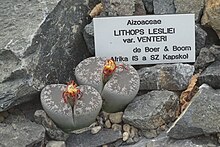
The Aizoaceae, or fig-marigold family, is a large family of dicotyledonous flowering plants containing 135 genera and about 1800 species. They are commonly known as ice plants or carpet weeds. They are often called vygies in South Africa and New Zealand. Highly succulent species that resemble stones are sometimes called mesembs.

Lithops is a genus of succulent plants in the ice plant family, Aizoaceae. Members of the genus are native to southern Africa. The name is derived from the Ancient Greek words λίθος 'stone' and ὄψ 'face', referring to the stone-like appearance of the plants. They avoid being eaten by blending in with surrounding rocks and are often known as pebble plants or living stones. Lithops is both the genus name and the common name. The formation of the name from the Ancient Greek -ops means that even a single plant is called a Lithops.
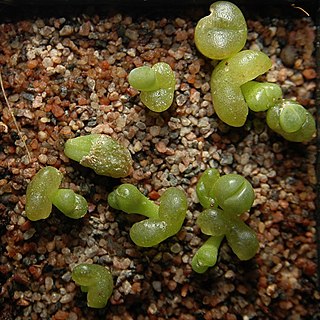
Lithops optica is a species of plant in the family Aizoaceae, endemic to Namibia.
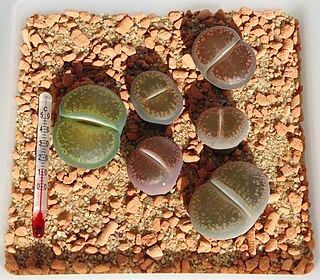
Lithops aucampiae is a species of flowering plant in the family Aizoaceae, found in South Africa. it was named after Juanita Aucamp, who found a specimen on her father's farm in Postmasburg, Northern Cape in 1929.

Lithops viridis is a species of plant in the family Aizoaceae.

Lithops salicola is a species of perennial plant in the family Aizoaceae, often called living stones, because of its resemblance to round grey pebbles.

Conophytum jucundum is a species of succulent plants belonging to the family Aizoaceae. As its synonym Conophytum gratum, the pleasing cone plant, it has gained the Royal Horticultural Society's Award of Garden Merit.

Lithops francisci, commonly known as one of the living stones or pebble plants, is in the family Aizoaceae. It is endemic to the arid desert environments of Namibia. It is a succulent with a natural habitat in rocky areas. L. francisci was assessed by Nicholas Edward Brown in 1925. It is one of the Lithops plants and shares the characteristic bi-leaf head pattern separated by a deep fissure, the bottom of which houses and protects the stunted stem.
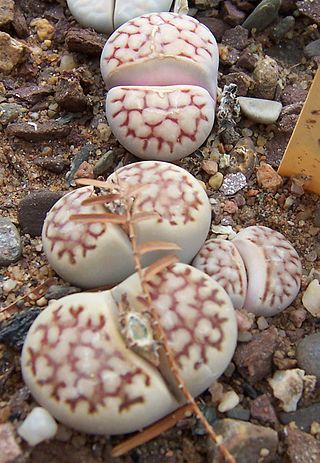
Lithops karasmontana, is a species of flowering plant in the ice plant family Aizoaceae, native to Namibia and South Africa.

Lapidaria is a monotypic genus of dwarf succulent plants in the family Aizoaceae. The only species it contains is Lapidaria margaretae, also known as the Karoo rose.
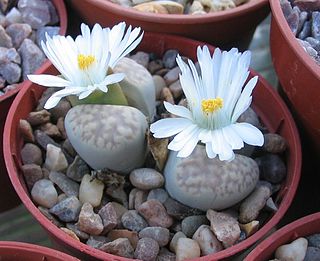
Lithops amicorum is a small succulent plant with white flowers, one of the smallest in the genus. It was named for the group of four friends who discovered it. It was collected by Desmond T. and Naureen A. Cole on 3 May 2004. After recent molecular analysis it was recombined to be a subspecies of Lithops karasmontana rather than its own species.

Lithops localis is a species of plant in the family Aizoaceae, indigenous to South Africa.
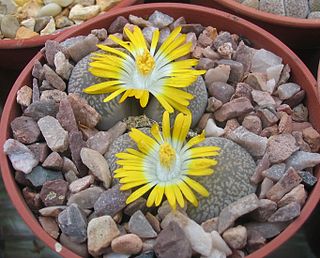
Lithops comptonii is a species of plant in the family Aizoaceae, indigenous to South Africa.
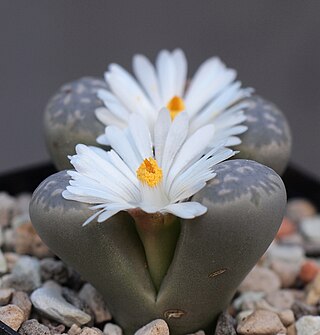
Lithops marmorata is a species of succulent pebble plant. It is native to the Northern Cape Province of South Africa. The specific name is derived from the Latin word marmorata meaning "marbled".

Lithops olivacea is a species of the genus Lithops under the family Aizoaceae. The name olivacea refers to the Latin word for olive (oliva) combined with the suffix -cea, meaning "of the likeness", producing the idea of "olive likeness". Lithops olivacea grow primarily in the Bushmandland of South Africa. They grow most abundantly in the regions of Aggeneys, Pofadder, and Namies. L. olivacea also received the Royal Horticultural Society's Award of Garden Merit for being "excellent for ordinary use in appropriate conditions, available to buy, of good constitution, essentially stable in form & colour, [and] reasonably resistant to pests & diseases."
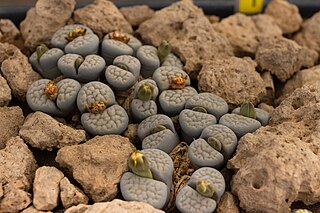
Lithops schwantesii is a succulent plant of the genus Lithops and a member of the family Aizoaceae. L. schwantesii receives its name from Gustav Schwantes, a prominent archaeologist and botanist of late 19th and 20th century. The succulent also received the Royal Horticultural Society's Award of Garden Merit for being a resilient and easy to cultivate plant.
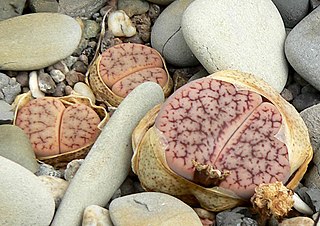
Lithops pseudotruncatella is a species of succulent in the family Aizoaceae. Initial confusion associated with Conophytum truncatum is where it derives its name, literally meaning "fake-truncatum". It also received The Royal Horticultural Society's Award of Garden Merit. The plant is endemic to Namibia.
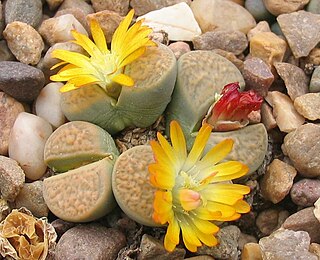
Lithops divergens is a succulent plant species in the genus Lithops of the family Aizoaceae. It is endemic to the western Cape Provinces of South Africa. It is able to withstand intense climatic changes due to its resilience as a succulent. The average annual rainfall for its natural environment is less than 150 mm, occurring primarily in winter which is unusual for a Lithops.
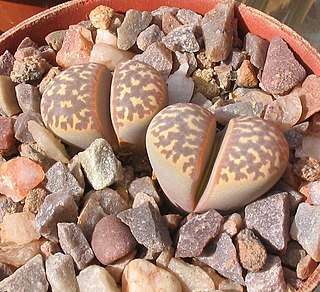
Lithops naureeniae is a species of pebble plant (Lithops), in the family Aizoaceae. It is native to the Northern Cape province of South Africa. The succulent is adapted to the desert climate in which it lives. L. naureeniae was identified in 1980 by Desmond Cole, who became involved in Lithops research in 1947, from a specimen provided to him by Bruce Bayer, curator of the Karoo Botanic Garden, having been collected by Peter V. Bruyns in Namaqualand. It is named after Cole's wife, Naureen Cole. Cole wrote:
I therefore have pleasure in dedicating it to the person who, during the last fifteen years, directly and indirectly, has contributed more to research on and knowledge of the genus Lithops than any other—my wife, Naureen
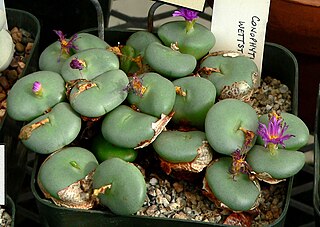
Conophytum wettsteinii is a species of flowering plant in the genus Conophytum, native to the northwest Cape Provinces of South Africa. It is known to grow in rocky regions, often nearby Crassula elegans. C. wettsteinii is a small groundcover species, which appears stemless with fused leaf-pairs having a obconical shape. This plant relies on winter rains and is mainly dormant in summer months. Best growth occurs when drainage is available, and when only shaded during mid-summer. PRopegation can occur through seeds or though cuttings from a full grown plant, where each cutting contains at least 1 head and a fraction of root. It has gained the Royal Horticultural Society's Award of Garden Merit.

